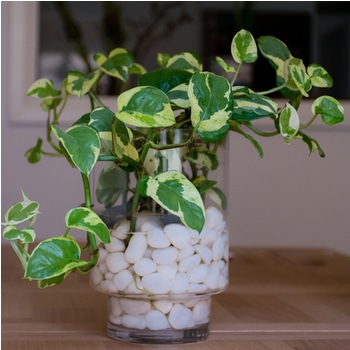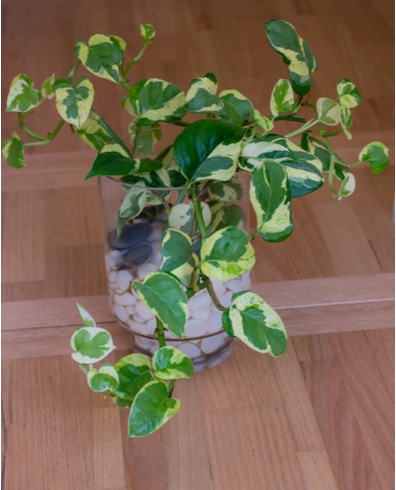Glacier pothos is a slow growing vine that has heart-shaped leaves. It works well as a houseplant because it tolerates low light conditions, is drought tolerant, and does not have high requirements for fertilizer.
Glacier Pothos is very easy to propagate from stem cuttings and is fast-growing. They can reach a height of approximately 6 feet in the wild but can be kept more compact as a houseplant. In this guide, we’ll look at how to grow and care for a glacier pothos plant.
What is a Glacier Pothos?
The glacier pothos is a member of the Araceae family and is a large houseplant that is widely grown for its attractive vine and foliage. Its botanical name is Epipremnum Aureum. The
leaves have white and silver variegations and are stunning and eye-catching. The Glacier pothos is often confused with other varieties such as the pearls n jade pothos or pothos n joy. These three varieties all have very similar variegated leaves. The difference is that the glacier pothos is slightly more compact and has smaller leaves.
Native to rainforests in tropical regions of Asia, this frost-tender perennial will die when exposed to even light freezes but can often regrow from the tips when warmer weather returns. These plants can be grown outdoors year-round in USDA Hardiness Zones 10 to 11. Their leaves are toxic to humans and animals if ingested so should be kept away from pets and young children.
How to care for a Glacier Pothos?
The Glacier pothos is relatively easy to care for as long as you get the basics of water, light, and humidity right. These plants are pretty forgiving when it comes to soil pH range and can cope with some neglect as they are fairly drought tolerant. This makes the glacier pothos an excellent choice for a beginner. Here are some tips to help you care for this beautiful tropical plant:
Sunlight needs
Bright indirect sunlight is best for your glacier pothos. These plants need between 6 to 8 hours of sunlight daily. Too much direct sunlight will cause discoloration due to sunburn, while too much shade will turn foliage yellow. Getting the sunlight correct will allow you to grow a beautiful, healthy plant.
Watering
To check if your pothos’ soil is dry, insert your finger into the top inch or two of soil; if it’s still moist, then don’t water yet. Don’t go overboard on water because pothos is sensitive and can easily suffer from root rot. In winter, cut back slightly on watering as your plant will naturally become dormant.
Fertilization
Too much fertilizer can damage your pothos, so dilute well before watering. It’s best to follow the instructions on the bottle carefully without overdoing it because too much fertilizer will burn roots and yellow foliage quickly. If you’ve over-fertilized your plant, you can flush the soil with water outside immediately to remove excess salts from around your pothos roots. It may be beneficial to use an organic product on your pothos plant as this will reduce the chance of burns occurring.
Pruning
Your glacier pothos will not require any pruning for aesthetics except occasionally removing dried leaves.
Soil
Use a well-draining soil mix like African violet mix or cactus potting soil with 1/3 composted bark and perlite added to provide aeration around roots. Glacier pothos likes soil that’s loose and aerated with a slightly acidic pH. A pH range of between 6.1 and 6.5 is ideal for these plants.
Humidity
If low humidity is a problem in your home use, a small humidifier to increase moisture levels. Alternatively, mist your plant leaves or use a pebble and water tray to increase the humidity to between 50 and 70%.
Pests
Aphids can occasionally appear on pothos plants but are usually quickly corrected when natural predators like ladybugs and praying mantis feast on the insects. Indoor plants can be treated with insecticidal spray or with neem oil.
Temperature
Glacier pothos does well at average room temperatures around 71 to 77 degrees F during the day but can tolerate slightly lower temps down into the low 60’s overnight without any damage.
Propagation
The glacier pothos can be propagated using stem cuttings which allows new plants to be obtained without waiting for seeds or seedlings to mature. This method requires only a few minutes, an existing healthy vining plant with one or more side-shoots and some rooting hormone.
The first step is to separate a 4 to 6-inch side shoot from the main stem of the Glacier Pothos vine using a sharp pair of pruning shears. The cutting should have several leaves on it and at least three pairs of leaf nodes. Remove any flowers that may be present in order to direct all energy into root production rather than seed growth.
- Use a rooting hormone on the cut end of the stem before planting your cutting in slightly damp soil. Allow the soil to dry until the top 1 to 2″ are dry before watering again.
- Your new Glacier Pothos cuttings should root within one to two months, provided they are kept in a warm, humid location of around 70 degrees Fahrenheit or slightly warmer.
- As soon as your Glacier Pothos plants have rooted and grown an inch or two of healthy new foliage, they are ready to be transplanted into larger containers.
Glacier Pothos grow well when planted directly into outdoor beds or containers once the chance of frost has passed for the season. A few hours of morning sun is all that this plant requires for healthy growth and care indoors or out. If planting in your garden, be sure to give each plant 6 to 8 inches on both sides, so it has room to grow wide as well as tall while still being able to receive enough sunlight.
Conclusion
Glacier pothos will perform best when grown outdoors where conditions are naturally better for them. Fertilize during the growing season with a good organic fertilizer and keep your plant in areas of high light year-round to control the plant’s size and spread. You can prune dead leaves occasionally in spring or summer when new growth appears, rinse off the foliage notice bugs such as aphids or mealybugs.

